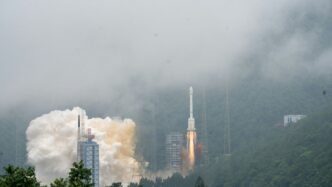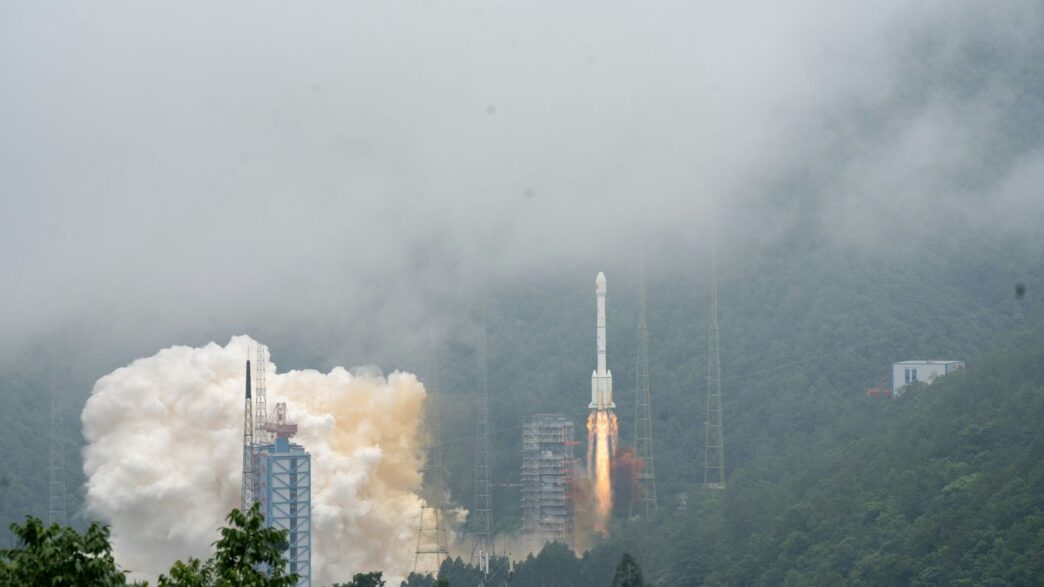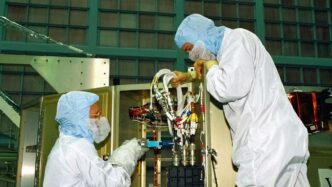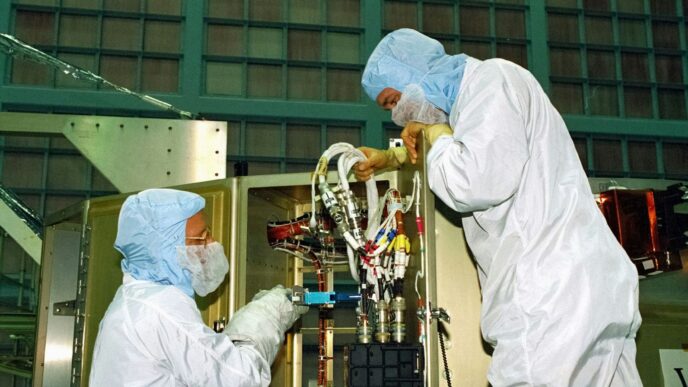China’s Expanding Satellite Constellations
China’s presence in orbit is growing at a breakneck pace. It’s not just about a few satellites anymore; we’re talking about massive networks, or constellations, designed to blanket the Earth with connectivity and data. This rapid build-out is reshaping the global space landscape.
The Rise of Guowang and Qianfan Networks
Two major players are leading the charge here: the Guowang (or Xingwang) network and Spacesail’s Qianfan constellation. Guowang, backed by China Satellite Network, has a plan for nearly 13,000 satellites. Qianfan, from Spacesail, is aiming for an even larger fleet of 15,000. These aren’t small projects; they’re mega-constellations intended to provide global internet services, directly competing with international efforts. While Qianfan already has a significant number of satellites in orbit, Guowang is also steadily deploying its assets. The goal is to have a robust, domestically controlled satellite internet infrastructure.
Commercial Space Players in China
It’s not all state-run projects, though. A growing number of commercial companies are jumping into the space race. Think companies like GalaxySpace, Commsat, and Tianqi. They’re developing everything from satellites for internet of things (IoT) communication to remote sensing satellites. The government is actively encouraging this, seeing it as a way to drive innovation and catch up with global leaders. These companies are getting more freedom to develop larger projects, including reusable rockets and, of course, their own satellite constellations. It’s a dynamic scene, with new players and ambitious plans emerging regularly.
Accelerated Launch Cadence for China Satellites
What’s really striking is how fast China is launching these satellites. For decades, China launched only a handful of satellites each year. But in recent years, that number has exploded. We’re now seeing over a hundred launches annually. This dramatic increase means China’s satellite population in orbit has grown from around 40 in 2010 to roughly 1,000 today. This accelerated launch cadence is key to building out these massive constellations quickly and establishing China’s dominance in various space-based services.
AI Integration in China’s Space Program
China is really pushing the envelope when it comes to putting artificial intelligence to work in space. It’s not just about launching satellites anymore; it’s about making them smarter and more capable. This push is about creating a more autonomous and efficient space infrastructure.
The Three-Body Computing Constellation
One of the most talked-about projects is the ‘Three-Body Computing Constellation.’ Think of it as a network of satellites designed from the ground up to handle complex computing tasks right there in orbit. The idea is to cut down on the time it takes to get data back to Earth and process it. This could be a game-changer for everything from real-time Earth observation to managing future space missions. Companies like ADA Space, which focuses on AI-driven satellite tech, are at the forefront of this. They’re aiming to build the foundational infrastructure for what could become space-based cloud computing.
On-Orbit Data Processing Capabilities
Having AI and powerful computing in space means satellites can do more on their own. Instead of just collecting raw data and sending it all back, they can analyze it, identify important patterns, and even make decisions. This is especially useful for missions that are far away or when quick responses are needed. It reduces the strain on ground control and speeds up the whole process. This capability is becoming increasingly important as the sheer volume of data collected from space continues to grow.
DeepSeek AI and Space Applications
Beyond specific constellations, China’s advancements in AI research, like those from DeepSeek, are also finding their way into space applications. DeepSeek has made waves with its efficient AI models, and the implications for space are significant. Imagine AI helping to manage complex satellite operations, improve navigation accuracy, or even assist in scientific analysis of celestial bodies. The synergy between cutting-edge AI development and space exploration is a key part of China’s strategy to become a major player in the final frontier.
Strategic Importance of China Satellite Deployments

It’s becoming pretty clear that China’s big push into space isn’t just about looking cool or exploring the stars. There’s a lot more going on behind the scenes, and it’s all tied into what the country wants to achieve on a global scale. Think of it as building a whole new infrastructure, but instead of roads and bridges, it’s satellites and data.
Geopolitical Competition and Space Infrastructure
This whole satellite thing is definitely part of a bigger game between nations. China is working hard to build its own space capabilities, aiming to be less reliant on other countries, especially the US. It’s like they’re saying, ‘We can do this ourselves.’ This drive for independence is really picking up steam. They’ve gone from launching just a few satellites a year to launching over a hundred annually in recent times. That’s a massive jump!
- Building a ‘Fortress China’: The goal is to create a self-sufficient technological base, from computer chips to AI, to better handle global rivalries.
- Global Reach: China’s satellite networks are expanding beyond its borders, with initiatives like the Space Silk Road aiming to connect more countries.
- Resilience: Having their own satellite systems means China can maintain communications and services even if other global networks are disrupted.
Technological Self-Sufficiency Goals
There’s a strong push to develop space technology without needing help from the West. This isn’t just about satellites; it’s a broader national strategy. The idea is to become a major space power, contributing significantly to the country’s growth. It’s a long-term dream that’s now being actively pursued.
Economic and Military Implications
These satellites aren’t just for show. They have real-world uses that impact both the economy and defense. They help with things like communication, observing the Earth for various purposes, and even weather forecasting. But they also play a role in military operations, providing reconnaissance, secure communications, and navigation support. It’s a dual-use approach, where civilian and military benefits go hand-in-hand.
| Satellite Function | Examples |
|---|---|
| Communications | Internet access, direct-to-device services |
| Earth Observation | Remote sensing, environmental monitoring |
| Navigation & Positioning | BeiDou system, vehicle guidance |
| Military Support | Reconnaissance, secure comms, intelligence |
Advancements in China’s Launch Capabilities
China’s ability to get things into space is really picking up speed. It’s not just about having more rockets; it’s about smarter ways to launch them and doing it more often. This surge shows strong government support and the looming demand from megaconstellations like Guowang and Qianfan.
Expansion of Operational Spaceports
China now operates six different launch sites. This expansion is a big deal because it means they can send up more rockets, more frequently. Think of it like having multiple highways instead of just one – traffic flows much better and you can move more goods. These sites are spread out, which also helps manage the increased launch tempo.
Sea Launch Innovations
Getting away from land-based launchpads has its advantages, and China is exploring this too. They’ve been working on launching rockets from ships. This approach offers flexibility, allowing launches from different locations and potentially avoiding some weather issues that can ground land-based launches. It’s a bit like having a mobile launchpad that can go where it’s needed.
Increased Rocket Launch Frequency
The number of rockets China is launching each year has gone up dramatically. Back in the day, it was just a few per year. Now, we’re talking about over a hundred annually. This isn’t just for government missions; commercial companies are also launching a lot more. This jump in frequency is driven by the need to build out those big satellite networks we’ve talked about, and also by the growing number of private companies that are now in the launch business. Some of these private outfits are even aiming to build rockets that can be reused, which could make launching things even cheaper and faster in the future. It’s a competitive scene, with companies like Landspace, Space Pioneer, and Galactic Energy all working on new designs.
China’s Space Silk Road Initiative

China’s Space Silk Road is more than just a catchy name; it’s a real push to extend the country’s influence and services into orbit, mirroring the broader Belt and Road Initiative. Think of it as building digital highways in the sky, connecting not just China but also partner nations through space-based tech. This initiative is all about using satellites for communication, navigation, and even Earth observation, making space a key part of global infrastructure.
Satellite Communications and Navigation Services
At the heart of this is making sure everyone can get connected, no matter where they are. China is building out massive satellite networks, like the Guowang and Qianfan constellations, which aim to provide internet access globally. These aren’t just for China; they’re designed to offer services to countries that join the Space Silk Road. It’s like offering a global Wi-Fi hotspot, but from space. This also includes improving navigation systems. The BeiDou Navigation Satellite System is a big part of this, offering precise positioning services that can be used for everything from shipping to everyday apps on your phone. The goal is to create a robust, interconnected space network that partners can rely on.
International Cooperation in Space
China isn’t trying to do this all alone. The Space Silk Road actively seeks partnerships with other countries. This means collaborating on satellite projects, sharing data, and developing space technology together. It’s a way to build relationships and create a shared infrastructure that benefits everyone involved. These collaborations can range from joint satellite launches to data-sharing agreements for Earth observation. It’s about creating a network effect, where more partners mean a stronger, more capable system for all.
BeiDou Navigation Satellite System
The BeiDou system is a prime example of China’s capabilities and its international ambitions. It’s China’s answer to GPS, but it’s also a key component of the Space Silk Road. With a growing number of satellites in orbit and a network of ground stations, BeiDou provides accurate positioning, navigation, and timing services. This system is not just for military or scientific use; it’s being integrated into civilian applications, from smartphones to logistics. The expansion of BeiDou is a clear signal of China’s commitment to providing global navigation services and building a self-sufficient, yet internationally connected, space ecosystem.
Looking Ahead: China’s Expanding Reach in Space
So, what does all this mean for the future? It’s pretty clear China isn’t just dipping its toes into space anymore; they’re making some serious waves. With all these new satellites going up and the push for AI in orbit, they’re building something big. It’s not just about having more satellites, but about how they’re going to use them – for better communication, more data processing right there in space, and maybe even things we haven’t thought of yet. This whole effort seems to be about getting ahead in a new kind of race, one that involves technology and influence. It’ll be interesting to see how this all plays out and what new capabilities China brings to the table in the years to come.














